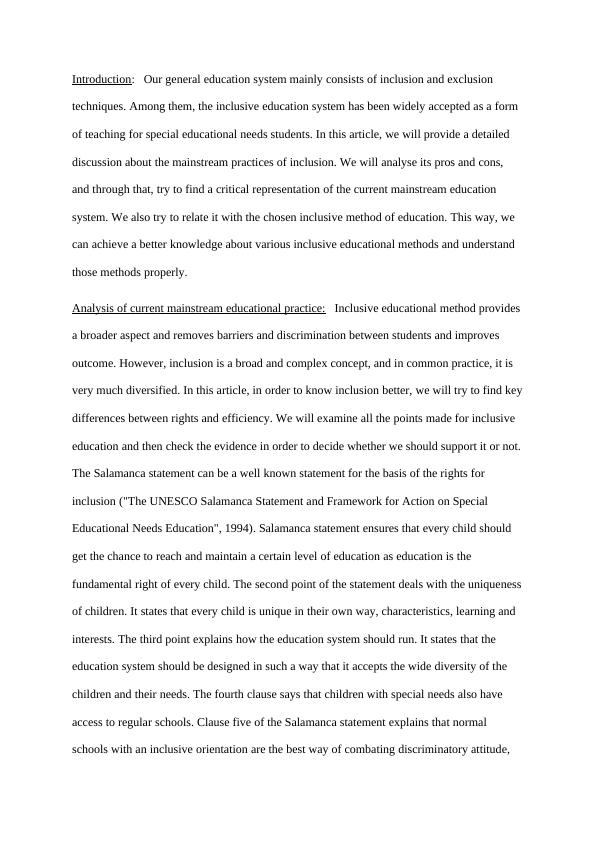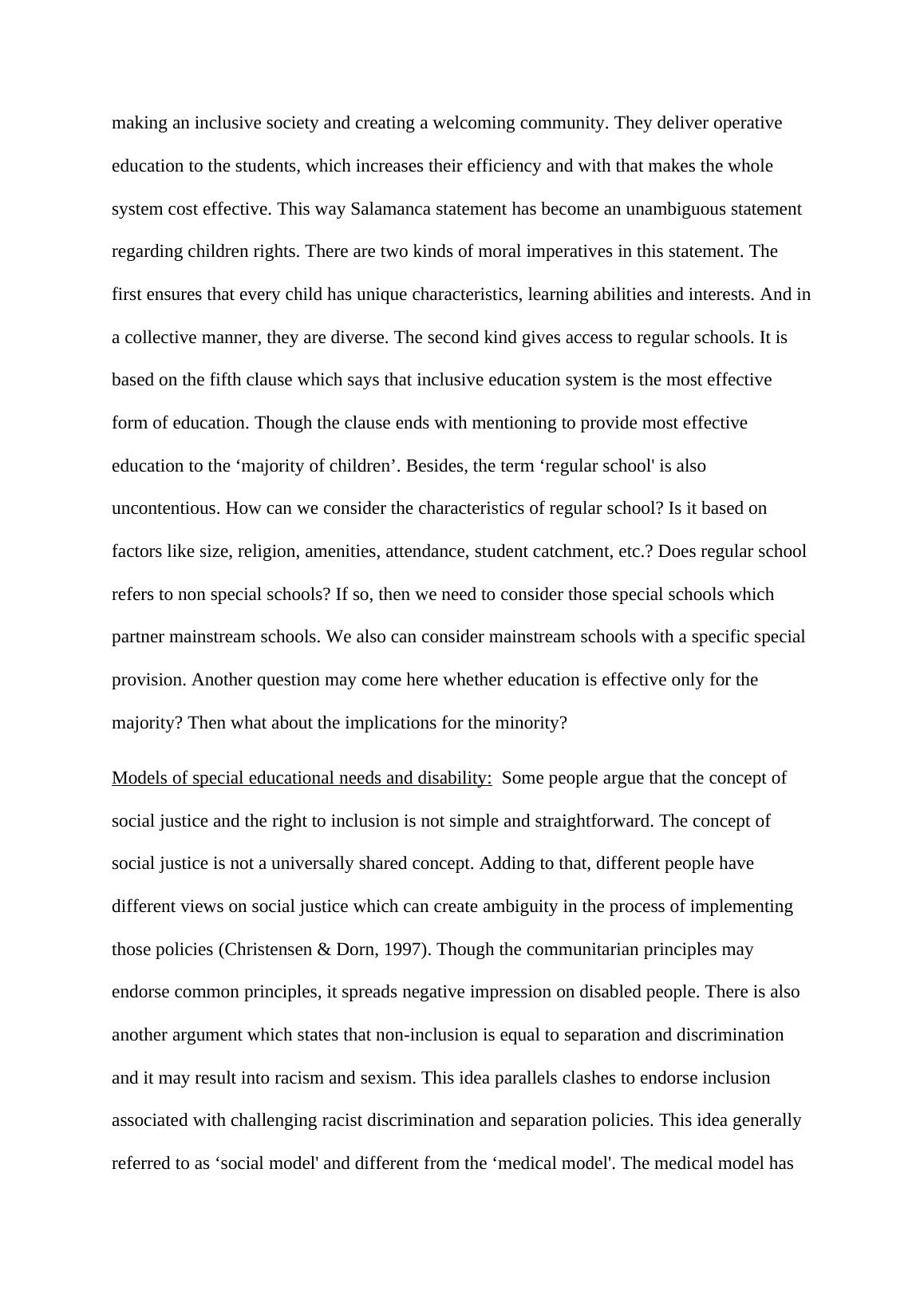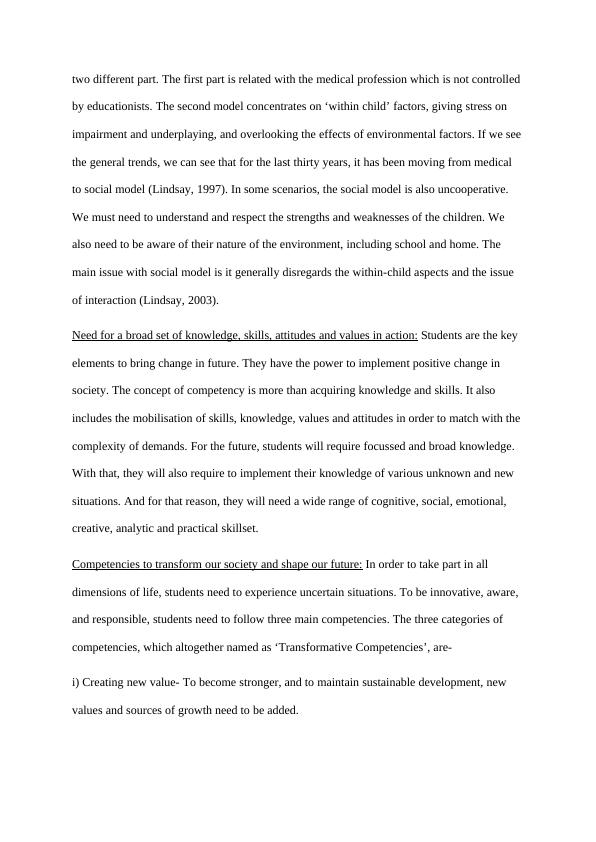Salamanca Statement and Framework
Added on 2022-09-16
7 Pages2041 Words37 Views
Introduction: Our general education system mainly consists of inclusion and exclusion
techniques. Among them, the inclusive education system has been widely accepted as a form
of teaching for special educational needs students. In this article, we will provide a detailed
discussion about the mainstream practices of inclusion. We will analyse its pros and cons,
and through that, try to find a critical representation of the current mainstream education
system. We also try to relate it with the chosen inclusive method of education. This way, we
can achieve a better knowledge about various inclusive educational methods and understand
those methods properly.
Analysis of current mainstream educational practice: Inclusive educational method provides
a broader aspect and removes barriers and discrimination between students and improves
outcome. However, inclusion is a broad and complex concept, and in common practice, it is
very much diversified. In this article, in order to know inclusion better, we will try to find key
differences between rights and efficiency. We will examine all the points made for inclusive
education and then check the evidence in order to decide whether we should support it or not.
The Salamanca statement can be a well known statement for the basis of the rights for
inclusion ("The UNESCO Salamanca Statement and Framework for Action on Special
Educational Needs Education", 1994). Salamanca statement ensures that every child should
get the chance to reach and maintain a certain level of education as education is the
fundamental right of every child. The second point of the statement deals with the uniqueness
of children. It states that every child is unique in their own way, characteristics, learning and
interests. The third point explains how the education system should run. It states that the
education system should be designed in such a way that it accepts the wide diversity of the
children and their needs. The fourth clause says that children with special needs also have
access to regular schools. Clause five of the Salamanca statement explains that normal
schools with an inclusive orientation are the best way of combating discriminatory attitude,
techniques. Among them, the inclusive education system has been widely accepted as a form
of teaching for special educational needs students. In this article, we will provide a detailed
discussion about the mainstream practices of inclusion. We will analyse its pros and cons,
and through that, try to find a critical representation of the current mainstream education
system. We also try to relate it with the chosen inclusive method of education. This way, we
can achieve a better knowledge about various inclusive educational methods and understand
those methods properly.
Analysis of current mainstream educational practice: Inclusive educational method provides
a broader aspect and removes barriers and discrimination between students and improves
outcome. However, inclusion is a broad and complex concept, and in common practice, it is
very much diversified. In this article, in order to know inclusion better, we will try to find key
differences between rights and efficiency. We will examine all the points made for inclusive
education and then check the evidence in order to decide whether we should support it or not.
The Salamanca statement can be a well known statement for the basis of the rights for
inclusion ("The UNESCO Salamanca Statement and Framework for Action on Special
Educational Needs Education", 1994). Salamanca statement ensures that every child should
get the chance to reach and maintain a certain level of education as education is the
fundamental right of every child. The second point of the statement deals with the uniqueness
of children. It states that every child is unique in their own way, characteristics, learning and
interests. The third point explains how the education system should run. It states that the
education system should be designed in such a way that it accepts the wide diversity of the
children and their needs. The fourth clause says that children with special needs also have
access to regular schools. Clause five of the Salamanca statement explains that normal
schools with an inclusive orientation are the best way of combating discriminatory attitude,

making an inclusive society and creating a welcoming community. They deliver operative
education to the students, which increases their efficiency and with that makes the whole
system cost effective. This way Salamanca statement has become an unambiguous statement
regarding children rights. There are two kinds of moral imperatives in this statement. The
first ensures that every child has unique characteristics, learning abilities and interests. And in
a collective manner, they are diverse. The second kind gives access to regular schools. It is
based on the fifth clause which says that inclusive education system is the most effective
form of education. Though the clause ends with mentioning to provide most effective
education to the ‘majority of children’. Besides, the term ‘regular school' is also
uncontentious. How can we consider the characteristics of regular school? Is it based on
factors like size, religion, amenities, attendance, student catchment, etc.? Does regular school
refers to non special schools? If so, then we need to consider those special schools which
partner mainstream schools. We also can consider mainstream schools with a specific special
provision. Another question may come here whether education is effective only for the
majority? Then what about the implications for the minority?
Models of special educational needs and disability: Some people argue that the concept of
social justice and the right to inclusion is not simple and straightforward. The concept of
social justice is not a universally shared concept. Adding to that, different people have
different views on social justice which can create ambiguity in the process of implementing
those policies (Christensen & Dorn, 1997). Though the communitarian principles may
endorse common principles, it spreads negative impression on disabled people. There is also
another argument which states that non-inclusion is equal to separation and discrimination
and it may result into racism and sexism. This idea parallels clashes to endorse inclusion
associated with challenging racist discrimination and separation policies. This idea generally
referred to as ‘social model' and different from the ‘medical model'. The medical model has
education to the students, which increases their efficiency and with that makes the whole
system cost effective. This way Salamanca statement has become an unambiguous statement
regarding children rights. There are two kinds of moral imperatives in this statement. The
first ensures that every child has unique characteristics, learning abilities and interests. And in
a collective manner, they are diverse. The second kind gives access to regular schools. It is
based on the fifth clause which says that inclusive education system is the most effective
form of education. Though the clause ends with mentioning to provide most effective
education to the ‘majority of children’. Besides, the term ‘regular school' is also
uncontentious. How can we consider the characteristics of regular school? Is it based on
factors like size, religion, amenities, attendance, student catchment, etc.? Does regular school
refers to non special schools? If so, then we need to consider those special schools which
partner mainstream schools. We also can consider mainstream schools with a specific special
provision. Another question may come here whether education is effective only for the
majority? Then what about the implications for the minority?
Models of special educational needs and disability: Some people argue that the concept of
social justice and the right to inclusion is not simple and straightforward. The concept of
social justice is not a universally shared concept. Adding to that, different people have
different views on social justice which can create ambiguity in the process of implementing
those policies (Christensen & Dorn, 1997). Though the communitarian principles may
endorse common principles, it spreads negative impression on disabled people. There is also
another argument which states that non-inclusion is equal to separation and discrimination
and it may result into racism and sexism. This idea parallels clashes to endorse inclusion
associated with challenging racist discrimination and separation policies. This idea generally
referred to as ‘social model' and different from the ‘medical model'. The medical model has

two different part. The first part is related with the medical profession which is not controlled
by educationists. The second model concentrates on ‘within child’ factors, giving stress on
impairment and underplaying, and overlooking the effects of environmental factors. If we see
the general trends, we can see that for the last thirty years, it has been moving from medical
to social model (Lindsay, 1997). In some scenarios, the social model is also uncooperative.
We must need to understand and respect the strengths and weaknesses of the children. We
also need to be aware of their nature of the environment, including school and home. The
main issue with social model is it generally disregards the within-child aspects and the issue
of interaction (Lindsay, 2003).
Need for a broad set of knowledge, skills, attitudes and values in action: Students are the key
elements to bring change in future. They have the power to implement positive change in
society. The concept of competency is more than acquiring knowledge and skills. It also
includes the mobilisation of skills, knowledge, values and attitudes in order to match with the
complexity of demands. For the future, students will require focussed and broad knowledge.
With that, they will also require to implement their knowledge of various unknown and new
situations. And for that reason, they will need a wide range of cognitive, social, emotional,
creative, analytic and practical skillset.
Competencies to transform our society and shape our future: In order to take part in all
dimensions of life, students need to experience uncertain situations. To be innovative, aware,
and responsible, students need to follow three main competencies. The three categories of
competencies, which altogether named as ‘Transformative Competencies’, are-
i) Creating new value- To become stronger, and to maintain sustainable development, new
values and sources of growth need to be added.
by educationists. The second model concentrates on ‘within child’ factors, giving stress on
impairment and underplaying, and overlooking the effects of environmental factors. If we see
the general trends, we can see that for the last thirty years, it has been moving from medical
to social model (Lindsay, 1997). In some scenarios, the social model is also uncooperative.
We must need to understand and respect the strengths and weaknesses of the children. We
also need to be aware of their nature of the environment, including school and home. The
main issue with social model is it generally disregards the within-child aspects and the issue
of interaction (Lindsay, 2003).
Need for a broad set of knowledge, skills, attitudes and values in action: Students are the key
elements to bring change in future. They have the power to implement positive change in
society. The concept of competency is more than acquiring knowledge and skills. It also
includes the mobilisation of skills, knowledge, values and attitudes in order to match with the
complexity of demands. For the future, students will require focussed and broad knowledge.
With that, they will also require to implement their knowledge of various unknown and new
situations. And for that reason, they will need a wide range of cognitive, social, emotional,
creative, analytic and practical skillset.
Competencies to transform our society and shape our future: In order to take part in all
dimensions of life, students need to experience uncertain situations. To be innovative, aware,
and responsible, students need to follow three main competencies. The three categories of
competencies, which altogether named as ‘Transformative Competencies’, are-
i) Creating new value- To become stronger, and to maintain sustainable development, new
values and sources of growth need to be added.

End of preview
Want to access all the pages? Upload your documents or become a member.
Related Documents
Strength Based Inclusive Educationlg...
|14
|3813
|143
Historical, Political, and Curricular Rationales for Inclusive Educationlg...
|4
|1745
|78
Perspectives in Special Needs and Inclusion in Educationlg...
|16
|4614
|467
Inclusive Education In Early Childhoodlg...
|15
|3876
|50
Inclusive Classroom Practices | Reportlg...
|8
|1789
|20
Early Childhood Studies Article 2022lg...
|13
|4037
|10
